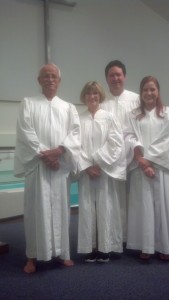 Dr. Sam Storms, A Brief Defense of Infant Baptism. I thought it might help everyone to hear a brief defense of believer’s baptism, or what we typically refer to as credo baptism. What follows is not a response to Kevin’s arguments, but simply an outline of the reasons why I remain a credo-baptist.
Dr. Sam Storms, A Brief Defense of Infant Baptism. I thought it might help everyone to hear a brief defense of believer’s baptism, or what we typically refer to as credo baptism. What follows is not a response to Kevin’s arguments, but simply an outline of the reasons why I remain a credo-baptist.
Why do I believe that only believers should be baptized in water? Why am I a “credo-baptist” rather than a “paedo-baptist” (the term “credo” comes from the Latin which means “I believe,” hence baptism for believers only; the term “paedo” comes from the Greek word for infant).
Before I answer that question, it may be helpful to briefly explain why some Christians baptize their infants. The primary reason comes from their understanding of the relationship between Old Testament circumcision and New Testament baptism.
In the Old Testament, male infants were circumcised as the outward sign of entrance into the covenant community of Israel. This did not guarantee their salvation, but marked them out as recipients of the external blessings of a national covenant into which they were introduced by physical birth.
Christian baptism, so goes the paedo-baptist argument, is the New Testament counterpart to Old Testament circumcision. It does not guarantee the salvation of the infant, but sets them apart as children of covenant parents who are thus included in the external blessings and responsibilities of the people of God. Baptized infants are thus “under the umbrella,” so to speak, of God’s new covenant blessings. Parents of the infant pray that he/she will personally receive the blessings of salvation in Christ which baptism signifies. They hope and trust that baptism is the foreshadowing of what will take place when their child personally embraces Jesus as savior. This is closely related to the idea that God deals not merely with individuals based on personal faith but with corporate entities based on covenant promise.
Paedo-baptists also appeal to what they call “household” baptisms in the New Testament (see Acts 16:15,33; and 1 Cor. 1:16). Surely, they contend, there must have been infants in these households. Infants of Christian parents, therefore, were made recipients of water baptism.
Why am I not convinced by this? Very briefly, for these reasons.
First, the narrative examples in the New Testament portray baptism as being administered only to believers. See Acts 2:41; 8:12; 10:44-48; etc.
Second, baptism is portrayed in the New Testament as a symbol of the beginning of spiritual life (Gal. 3:27; Rom. 6:3-4; Col. 2:12), as well as “an appeal to God for a good conscience” (1 Peter 3:21). Unless one is prepared to predicate salvation and spiritual life of unbelieving infants, or suggest that they are capable of making a conscious appeal to God for a good conscience, it would appear that baptism is restricted to those who consciously trust Christ.
Third, baptism is consistently portrayed as inextricably tied up with (conscious) faith and repentance (e.g., Acts 2:38,41; 8:12-13,36; 10:47-48). This is especially the case with Colossians 2:12, which I’ll deal with below.
Fourth, in all examples of so-called “household” baptisms the broader contexts make clear that only “believers” were baptized. As for Acts 16:15 and 16:33, members of the “household” were old enough to hear and understand “the word of the Lord” spoken to them (Acts 16:32; thereby excluding infants) and old enough to understand what it meant for a person to believe in God and thus have reason to rejoice because of it (Acts 16:34; thereby again excluding infants; see also John 4:53).
As for 1 Corinthians 1:16, we see in 1 Corinthians 16:15 that the “household” of Stephanas, whom Paul baptized, “were the first converts in Achaia” who “devoted themselves to the service of the saints.” As for the “children” in Acts 2:39, they are at least old enough to be “called” by the Lord (v. 39). And then, as if to confirm it, Luke records that “those who received his word were baptized” (Acts 2:41). There is no indication that those who were too young to respond to the “call” of God and too young to “receive” God’s word were baptized.
Fifth, we must take into account the nature of the New Covenant inaugurated by the death and resurrection of Jesus and one way (although there are many) in which it differs from the covenant God made with Abraham.
We read in Hebrews 8:11 of one of the chief characteristics of the New Covenant and those who are members of it – “And they shall not teach, each one his neighbor and each one his brother, saying, ‘Know the Lord,’ for they shall all know me, from the least of them to the greatest” (Heb. 8:11).
During the time of the Old Testament, the people of God were a mixed community. That is to say, Israel was composed of both believers and non-believers. Not everyone who was circumcised in his flesh was circumcised in his heart. Again, this simply means that not everyone who received the physical sign of the old covenant was born again or regenerate.
This is why members of the nation Israel had to be exhorted to “know” the Lord. But under the New Covenant we encounter an entirely different situation. Every member of the New Covenant is a believer. Every member of the New Covenant has been born again. Notice what our author says: “they shall all know me, from the least of them to the greatest” (8:11).
This promise that every member of the new covenant will experience personal and first-hand intimate saving knowledge of God is one of the main reasons I don’t baptize infants at Bridgeway Church.
We must remember that God’s covenant with Israel was theocratic in nature. Israel was not only the people of God; Israel was also a political entity. Therefore, all those who were circumcised physically were members of the covenant community whether they ever came to saving faith or not. That’s not true in the New Covenant. Only those who come to saving faith are members of the new covenant community.
To say that every member of the New Covenant knows the Lord doesn’t mean that there aren’t in our midst people who claim to know Christ but don’t. But those who are genuinely saved and genuinely members of the New Covenant are all born again and justified by faith in Jesus.
As noted above, paedo-baptists say that since in Old Testament times circumcision, as the sign of the covenant, was applied to all, even though many never came to saving faith, baptism, as the sign of the New Covenant, should be applied to all, even though many who are baptized will never come to saving faith.
But the New Covenant differs significantly from every biblical covenant that preceded it and thus the analogy breaks down. Unlike in the OT, everywhere in the NT we read that members of the New Covenant are born-again, justified believers in Jesus. Therefore it is only to them that the ordinance of baptism is applied. Members of the New Covenant are those who have the law of God written on their hearts; they are those who belong to God in a relationship of personal intimacy; they are those know God; they are those whose sins have been forgiven. That is why we do not baptize infants at Bridgeway. Infants who have not as yet trusted Christ for salvation are not members of the New Covenant.
Sixth, I can’t help but notice the absence in the New Testament of any explicit portrayal of an infant ever being baptized.
But let’s look more closely at Colossians 2:11-12, where Paul writes, “In him also you were circumcised with a circumcision made without hands, by putting off the body of the flesh, by the circumcision of Christ, having been buried with him in baptism, in which you were also raised with him through faith in the powerful working of God, who raised him from the dead.”
Contrary to the paedo-baptist argument, the New Testament counterpart to Old Testament circumcision isn’t baptism; it’s regeneration or the new birth. Or again, it is spiritual circumcision of the heart, not water baptism, that corresponds in the New Covenant to Old Covenant physical circumcision of the flesh. [By the way, even if one were to concede that water baptism is the New Covenant counterpart to Old Covenant circumcision, the former is consistently predicated on the faith of the individual, unlike the latter. Indeed, this is the very point of Colossians 2:12, as I’ll note below.]
Water baptism is a sign of the circumcision of the heart and the new life and cleansing from sin that it brings. The sign of the New Covenant isn’t baptism, but spiritual circumcision or regeneration or the “cutting away” of the heart of flesh, of which water baptism is an outward, symbolic expression.
But more important still is Paul’s reference to “faith” in v. 12. John Piper has summarized this better than anyone I’ve read, so let me close by quoting his words:
“If baptism were merely a parallel of the Old Testament rite of circumcision it would not have to happen ‘through faith’ since infants did not take on circumcision ‘through faith.’ The reason the New Testament ordinance of baptism must be ‘through faith’ is that it represents not the Old Testament external ritual, but the New Testament, internal, spiritual experience of circumcision ‘without hands.’
Those two words, ‘through faith,’ in verse 12 are the decisive, defining explanation of how we were buried with Christ in baptism and how we were raised with him in baptism: it was ‘through faith.’ And this is not something infants experience. Faith is a conscious experience of the heart yielding to the work of God. Infants are not capable of this, and therefore infants are not fit subjects of baptism, which is ‘through faith'” (“Buried and Raised in Baptism through Faith,” a sermon on Colossians 2:8-15, May 11, 1997; www.desiringgod.org).
I love my paedo-baptist friends and rejoice in their love for God. But I remain unconvinced by their arguments. Needless to say, this is a subject deserving of book-length treatment, but I hope my brief comments here are of help as you seek to obey Scripture with regard to this precious ordinance of God.
 Dr. John Piper on John 7:53 to John 8:11:
Dr. John Piper on John 7:53 to John 8:11:



